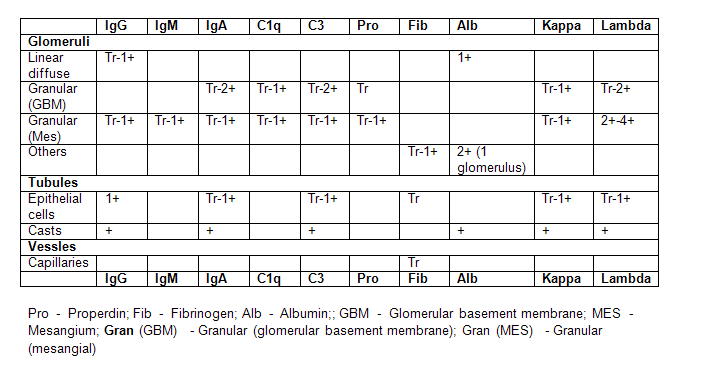
![]() Contributed by Nidhi Aggarwal, MD and Sheldon Bastacky, MD
Contributed by Nidhi Aggarwal, MD and Sheldon Bastacky, MD
CLINICAL HISTORY
21-year-old non-diabetic man presented with acute renal failure, approximately 2 weeks following a "sore throat". The patient has a history of HIV and hepatitis. Pertinent laboratory investigations: Creatinine: 4.5 mg/dl, BUN: 65 mg/dl, potassium: 6.0 mEq/ml, ANA: not available, anti-double stranded DNA antibody: negative, ANCA: negative, anti-GBM antibody: negative, ASO antibody: negative, C3: 98 mg/dl, C4: 28 mg/dl, HIV antibody: positive, hepatitis B surface antibody: positive, hepatitis B surface antigen: negative, hepatitis C antibody: negative, rheumatoid factor: negative, SPEP / UPEP: no evidence of a monoclonal immunoglobulin. Urine sediment: contains red blood cells, urine protein: 2.5 gm/24 hrs, Urine toxicology: positive for marijuana and opiates.
LIGHT MICROSCOPY
The biopsy consists of renal cortex and medulla. The profiles of approximately 45 glomeruli are identified in the paraffin, frozen, and plastic sections, of which none were sclerotic.
The glomeruli exhibit diffuse and global endocapillary proliferation with abundant circulating neutrophils within the glomerular capillaries (exudative) component. Approximately three or four of the glomeruli (paraffin and frozen sections) have small cellular / fibrinous crescents. Two or three of the glomeruli have thrombosed glomerular capillary microaneurysms. There are no well-defined necrotizing lesions, basement membrane breaks, glomerular capillary wall thickening, spikes, or tram tracking (PAS and silver stains).
The tubules show no appreciable acute injury or chronic atrophy. There are a small number of hyaline casts, few granular casts, few tubular luminal red blood cells, and few tubular luminal sloughed epithelial cells. Silver stain reveals protein resorption droplets within many of the proximal tubular epithelial cells.
The interstitium is unremarkable, without inflammation or fibrosis (trichrome stain).
Intrarenal arteries and arterioles show no histologic abnormality. There is no evidence of vasculitis, thromboemboli, or thrombotic microangiopathy.
IMMUNOFLUORESCENCE:
The renal tissue examined by immunofluorescence microscopy contains 11 hypercellular, non-sclerotic glomeruli, no arteries and rare arterioles.

INTERPRETATION:
ELECTRON MICROSCOPY
The ultrastructural findings are based on the examination of two glomeruli with endocapillary proliferation and neutrophil exudation. There is extensive and widespread podocyte foot process effacement. The mesangial areas are expanded and contain increased numbers of mesangial cells, and numerous, intermediate size, well-defined, electron dense deposits of immune complex type. The glomerular basement membrane is of a normal thickness. There are scattered, intermediate to large hump-like, subepithelial immune complex deposits. A few subendothelial immune complex deposits are also identified. No glomerular basement membrane breaks are present. A few of the glomerular capillary contain circulating polymorphonuclear white blood cells. No endothelial cells cytoplasmic tubuloreticular inclusions identified. The tubules and interstitium are unremarkable.